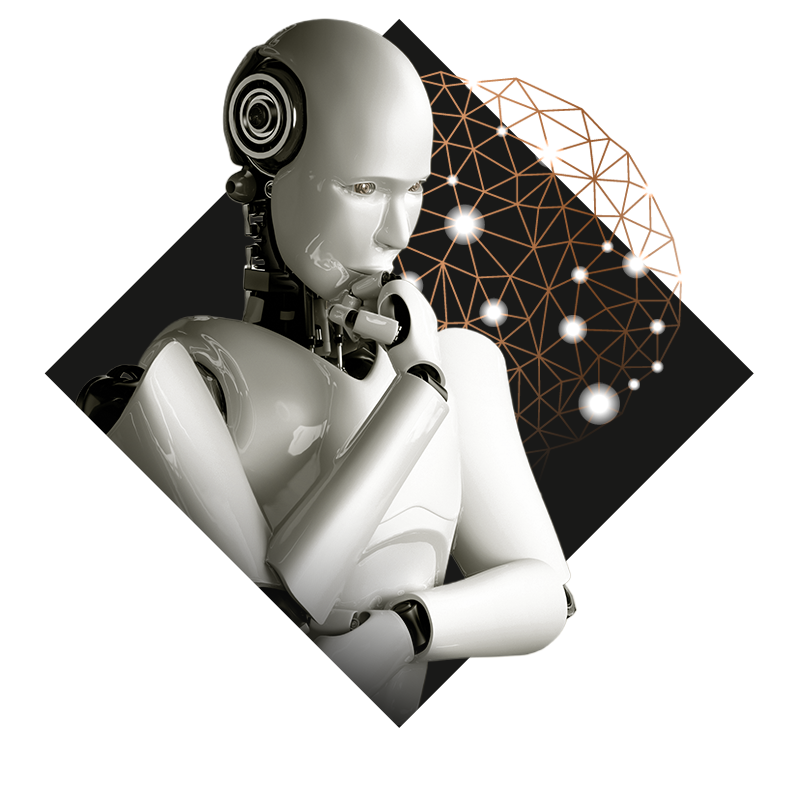


Multi-Model AI Integration for Enterprise
Unified AI That Moves Your Business Forward
Most enterprise AI failures don’t happen because the models are weak – they happen because the models aren’t connected. When systems work in isolation instead of collaboration, even the smartest AI tools can’t deliver real ROI.
Consider the cost of fragmentation: Your customer service LLM and multimodal AI can’t access sentiment insights from support calls. Your fraud detection system flags anomalies but lacks context from transaction narratives. Your vision-based quality control model raises alerts your predictive tools can’t prioritize. The result? AI investments that generate noise instead of value.
As a highly regarded European software development company, Acropolium builds unified multi-model AI ecosystems where every model shares context, strengthens the others, and produces aligned, meaningful outcomes that actually drive business value.
Let’s Acropolium to integrate multiple AI models for maximum ROI
You’ve already invested in chatbots, computer vision, predictive analytics, and natural language models. But instead of collaborating, they sit in silos – generating fragmented insights, creating duplicated work, and leaving your teams manually bridging the gaps?The result? Missed opportunities, inefficiency, and executives wondering why your AI spend isn’t showing up on the bottom line.
As a result you get missed opportunities, inefficiency, and low performance. Moreover, every unconnected model eats up your revenue. Every manual handoff adds latency, cost, and risk.
At Acropolium, we fix that. As a top-rated multi-model AI integration company, we connect and orchestrate your existing AI systems into one cohesive, intelligent network that actually moves business metrics – not just dashboards.
We create the best-in-the-industry AI multi-model solutions that boost business-driven results at scale.
custom projects delivered
startups grown into unicorns
industries served


Why Multi-Model Integration Matters for Success of Your Business
If your AI investments aren’t delivering the returns you expected, the issue probably isn’t the models themselves – it’s how they’re set up. When AI systems work in isolation, they create hidden costs that quietly drain resources and limit what you can achieve. Here’s what that fragmentation is actually costing you.

Hidden Costs of Disconnected AI Systems
Every day your AI models operate in isolation, your organization quietly pays a heavy price. Engineers waste 40-60% of their time writing brittle point-to-point integrations instead of improving model performance. Your ops teams manually reconcile conflicting recommendations from systems that should be collaborating. Decision-makers receive incomplete intelligence because the full picture requires combining insights across models nobody has connected. And the cause isn’t lack of innovation – it’s lack of integration of various AI models into one unified system.

Technical Debt That Scales Exponentially
The more AI you deploy, the more complex the web becomes. Each new model requires custom connectors to every other model. Soon you’re juggling dozens of fragile integrations that consume more engineering effort than they save. Different data formats, incompatible schemas, and redundant preprocessing pipelines pile up. Security policies diverge. Compliance becomes unmanageable. Your infrastructure turns into a brittle ecosystem no one dares touch. Scaling isolated models doesn’t just get harder – it gets prohibitively expensive. You’re paying to maintain complexity instead of funding innovation.

Revenue Opportunities You’re Missing
Isolated models can’t deliver intelligent automation or cross-functional insight. Imagine if your vision model for product recognition could trigger your marketing LLM to generate real-time recommendations. Or if your sales forecasting engine could explain its results through natural language summaries. That’s the power of integration. Companies implementing AI multi-model solutions see 30-50% higher prediction accuracy, 40-60% lower operational costs, and 20-35% revenue growth through synergy-driven innovation. This isn’t a theory. It’s happening in enterprises today that moved beyond disconnected tools to unified AI ecosystems.
Our Proven Approach to Multi-Model Integration
At Acropolium, as a trusted multi-model AI integration company, we’ve built multi-model systems for hospitals analyzing millions of records, banks processing billions of transactions, and manufacturers running global operations. Our integration methodology blends AI model orchestration, cross-model data pipelines, and enterprise-ready architecture – all aligned with your KPIs.

Identifying Business Value Before Writing Any Code
We start by identifying where fragmentation costs you the most. Our highly skilled developers analyze your current systems, workflows, and AI stack to map where models overlap, duplicate effort, or leave critical gaps. Then, we prioritize integrations that generate rapid ROI – often improving performance metrics within weeks.

Building Data Pipelines That Maintain Context
We ensure every piece of information travels between models seamlessly. This means your LLM can access sentiment scores from customer interactions, or your predictive maintenance model can incorporate visual inspection data from cameras. The result: contextual understanding that drives sharper insights and automated decisions.

Testing and Monitoring to Ensure Continuous Improvement
Once your system is live, we embed intelligent monitoring and retraining frameworks that detect model drift, data inconsistencies, and workflow bottlenecks early. Automated retraining workflows keep your models aligned with new data. Our dashboards track system health, ROI metrics, and inter-model dependencies so you always know what’s working and what needs fine-tuning.

Designing Architecture That Scales with You
We create orchestration layers that enable AI model interoperability and future-proof your infrastructure. Add new models without rewriting workflows. Swap components without touching business logic. Scale horizontally as your data and use cases grow. We design hybrid AI systems that adapt – not break – when your business growths.

Implementing Orchestration for Business Outcomes
Most integrators stop at connecting APIs. At Acropolium, we go further – implementing AI model orchestration engines that optimize how and when models collaborate. We use intelligent routing, confidence-based sequencing, and conditional logic that dynamically selects the best model for each task. When uncertainty rises, additional models verify results before action.

Key Multi-Model Integration Use Cases Acropolium Covers
Our next-gen AI multi-model solutions address complex business challenges across various industries. They demonstrate how integrating multiple AI models creates capabilities that single-purpose systems cannot match.
Finance: Fraud Detection and Risk Management
Banks and financial institutions are dealing with a new generation of fraud – faster, smarter, and harder to detect. At Acropolium, we help them fight back with multi-model AI that connects predictive machine learning and large language models (LLMs) into one intelligent fraud-prevention system. The predictive side spots irregularities – transactions that look just a bit off, unusual spending patterns, or location mismatches. Meanwhile, the language model reads between the lines, scanning transaction notes, merchant names, and messages for subtle signs of manipulation. When both models raise concern, the system can automatically pause the transaction or ask for extra verification. It’s a proactive, layered defense that helps financial teams react instantly, cut false alerts, and stop fraud before it becomes a loss.
Manufacturing: Predicting Failures Before They Happen
In manufacturing, data comes from everywhere – sensors, cameras, maintenance logs, production schedules. At Acropolium, we connect the dots. We combine predictive models that monitor equipment, computer vision that checks quality, and language models that generate maintenance guidance, creating a single system that actually works for your operations. Our sensors catch early signs of equipment problems, while cameras inspect for visible issues like worn parts or misalignment. Then, the AI produces clear maintenance recommendations, informed by past incidents and manufacturer guidelines. The result? Fewer surprises, less downtime, and smarter maintenance planning. Instead of separate systems, your teams get one integrated workflow that keeps production running efficiently.
Customer Support: Doubling Automation Efficiency
Modern customer support demands more than out-of-the-box chatbots. It requires smart systems that understand context, detect emotions, and access relevant information. We integrate NLP-powered chatbots with sentiment analysis models and knowledge retrieval systems. This integration eliminates common chatbot failures: misunderstanding context, providing outdated information, or failing to recognize when customers need human help. The system learns from interactions, improving its ability to match customer needs with appropriate resources. For enterprises, this translates to higher resolution rates, improved customer satisfaction scores, and reduced support costs.
Retail and e-Commerce: Turning Behavior into Personalization
Retail success today is all about personalization — and that’s where Acropolium makes a difference. We bring together computer vision and LLMs to help retailers connect in-store activity with digital engagement in real time. Our computer vision systems analyze shelf conditions, monitor inventory, and track foot traffic patterns to understand how customers actually shop. This data feeds into predictive models that forecast demand, optimize restocking, and ensure every store layout maximizes visibility and conversion. Meanwhile, our language models analyze such customer data as purchase history, browsing behavior, and reviews to get insight to craft personalized product recommendations, dynamic descriptions, and targeted offers that resonate with each client.
Marketing and Media: Multimodal Content Intelligence
At Acropolium, we build multimodal AI systems that analyze campaign effectiveness by integrating video analytics, image recognition, text sentiment analysis, and predictive models for campaign optimization. Integrated platforms process video content to identify key moments, brand appearances, and emotional responses. Image models analyze visual themes, color schemes, and composition. Text models extract sentiment from captions, comments, and social media discussions. The predictive component forecasts which content variations will perform best with specific audience segments. Such a multi-model approach enables dynamic content personalization: the system automatically selects image variants, adjusts messaging tone, and chooses distribution channels based on real-time performance data, so you can get significantly better ROI on advertising spend.
Healthcare: Fewer Diagnostic Errors, Faster Outcomes
Healthcare today demands AI that does more than just analyze images or text in isolation. With multi-model AI systems developed by Acropolium, clinicians get more than raw diagnostics – they receive insights that combine medical imaging, patient history, current medications, and patterns from similar cases. This integrated view helps reduce errors and gives doctors the full context they need to make confident, informed decisions without piecing together information from multiple disconnected systems.
What Acropolium Offers: Comprehensive Multi-Model Integration Services That Deliver Results
Being a full-service multi-model AI integration company, Acropolium offers end-to-end integration – from initial architecture to enterprise deployment – ensuring your AI ecosystem performs cohesively, securely, and profitably.


Get a free software project consultation
FAQ
- What is multi-model AI integration?
What is multi-model AI integration?
Most companies run separate AI systems – chatbots, computer vision, predictive models – that don’t share information. Multi-model integration connects them into one coordinated system. Your language models can pass insights to your vision systems. Your analytics can inform your forecasting. Each model’s output feeds into the others, creating a workflow where they compensate for each other’s limitations and build on each other’s strengths. Instead of isolated tools producing fragmented results, you get an integrated system that processes complete context and delivers more accurate decisions.
- Which industries benefit most from multi-model AI solutions?
Which industries benefit most from multi-model AI solutions?
Any industry juggling multiple data types. Finance, healthcare, manufacturing, retail, logistics – if you’re dealing with text and images and numbers and audio all at once, integration helps. A bank could combine transaction data with text analysis of customer messages to spot fraud patterns. A hospital could link medical imaging with patient records and research databases for better diagnoses. When you stop analyzing data in silos and start connecting the dots, you find patterns that were invisible before.
- What challenges exist in multi-model integration?
What challenges exist in multi-model integration?
The technical reality is messier than it sounds. APIs don’t play nice with each other. Data formats clash. One model expects JSON, another wants CSV, a third needs images preprocessed in a specific way. And orchestrating all of this – deciding which model runs when, how they hand off results, what happens if one fails – gets complicated fast. We’ve spent years building frameworks that handle this complexity so your team doesn’t have to rebuild the wheel every time you add a new AI model.
- Why choose Acropolium as your multi-model AI integration company?
Why choose Acropolium as your multi-model AI integration company?
We’ve done successful enterprise multi-model AI deployments across enough industries – finance, healthcare, manufacturing – to know where the real problems hide. Our approach isn’t “let’s throw every trendy model at your problem”. It’s “what actually moves your metrics?” We pick models based on what works for your specific situation, build systems that won’t collapse when you scale, and stick around to optimize performance as your needs evolve. Integration isn’t a one-time project for us – it’s an ongoing partnership.
- How much does it cost to implement a multi-model AI system?
How much does it cost to implement a multi-model AI system?
It depends – and anyone who gives you a fixed number up front isn’t being straight with you. Costs vary based on how many models you’re connecting, your data volume, infrastructure requirements, and how complex your workflows are. We start with an assessment that maps out what you actually need and what the ROI looks like, so you can understand what returns to expect and make informed investment decisions.
- How does multi-model integration differ from multimodal learning?
How does multi-model integration differ from multimodal learning?
Multimodal learning is one neural network trained to understand multiple input types at once – like a model that can process both text and images natively. Multi-model integration is different: you’re connecting separate, specialized models (each doing one thing well) into a coordinated system. The advantage? You can swap models out, upgrade individual pieces, and leverage best-in-class tools for each task without retraining everything from scratch.










